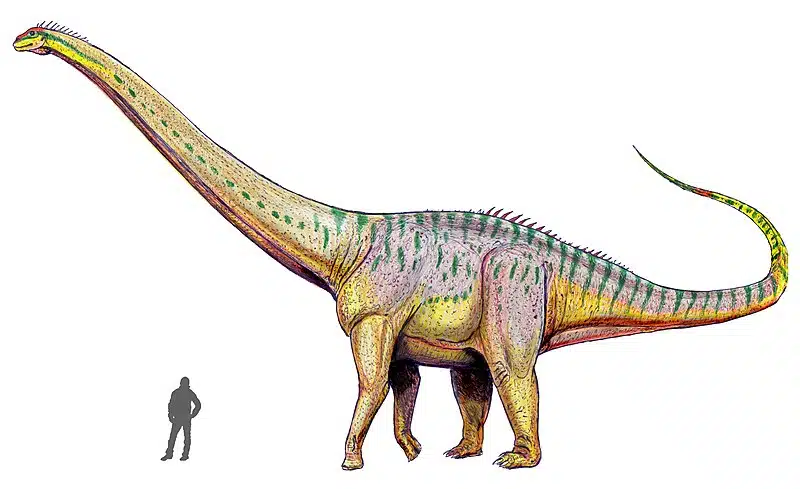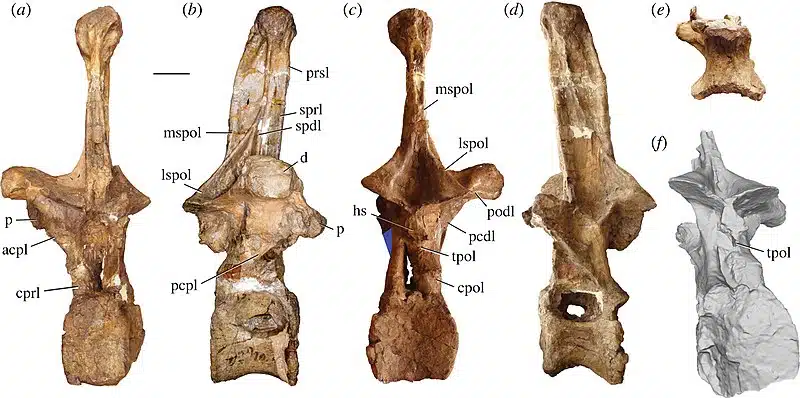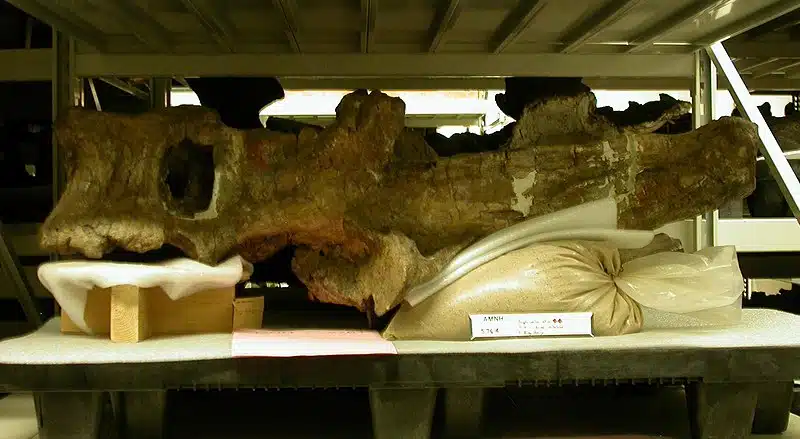Amphicoelias, an enormous dinosaur from the Late Jurassic Period, has intrigued and perplexed paleontologists for over a century. This giant herbivore, whose name means “biconcave/hollow on both sides,” roamed the earth approximately 150.0 to 145.0 million years ago. Discovered in Colorado in 1877, Amphicoelias stands as a testament to the incredible diversity and scale of prehistoric life.
A close relative of the famed Diplodocus, this colossal sauropod belonged to the diplodocid family, characterized by their long necks, whip-like tails, and immense bodies. Amphicoelias altus, the type species, offers a glimpse into the awe-inspiring world of dinosaurs, capturing our imaginations and prompting us to learn more about these magnificent creatures.
Amphicoelias Key Facts
| Keyword | Fact |
|---|---|
| Pronunciation | Am-fi-see-lias |
| Meaning of name | Biconcave on both sides |
| Group | Sauropoda |
| Type Species | Amphicoelias altus |
| Diet | Herbivore |
| When it Lived | 150.8 to 145.0 MYA |
| Period | Late Jurassic |
| Epoch | Early Tithonian |
| Length | 59.0 to 82.0 ft |
| Height | 30.0 ft |
| Weight | 15.0 to 20.0 tons |
| Mobility | Moved on all four legs |
| First Discovery | 1877 by Oramel William Lucas |
| Described by | 1878 by Edward Drinker Cope |
| Holotype | AMNH 5764 |
| Location of first find | Cretaceous Dakota Formation, Colorado |
Amphicoelias Origins, Taxonomy, and Timeline
The name Amphicoelias is derived from Greek, with “amphi” meaning “on both sides” and “koilos” meaning “hollow” or “concave.” This name aptly describes the concave vertebrae that are characteristic of this and other closely-related dinosaurs. Such a name not only reflects its physical traits but also the Greek influence on paleontological nomenclature, providing a window into the history of scientific discovery.

Amphicoelias belongs to the sauropod group and is a member of the diplodocid family. The type species, Amphicoelias altus, is the primary representative of this genus. Unlike many other dinosaurs, Amphicoelias does not have any recognized subspecies, although this simplified taxonomy is only due to years’ worth of painstaking palaeontological sleuth work. This giant herbivore shares its family with other well-known dinosaurs such as Diplodocus and Apatosaurus, which helps paleontologists understand its evolutionary relationships.
This magnificent creature roamed the Earth during the Late Jurassic Period, specifically in the Early/Lower Tithonian Epoch, approximately 150.8 to 145.0 million years ago. This timeline places Amphicoelias among some of the most iconic dinosaurs, allowing us to piece together a vivid picture of its environment and the ecosystems it was part of.
Listen to Pronunciation
To listen to the correct pronunciation of this dino’s name, check out this video.
Discovery & Fossil Evidence
Amphicoelias was first unearthed in 1877 from a large bone-bed discovered by Oramel William Lucas in Colorado. Amongst this quarry was a specimen that included multiple dorsal vertebrae, a pubis, and a femur bone. These were later sent to the renowned paleontologist Edward Drinker Cope, who identified the dinosaur on what was then thought to be a distinctive feature of its vertebrae. Cope also assumed that the remains came from the Cretaceous Dakota Formation, although they have now been interpreted as coming from the Late Jurassic Morrison Formation, which is more consistent with their diplodocid affinity. This confusion aside, the holotype specimen, labeled AMNH 5764, remains a critical piece of evidence in understanding this giant sauropod.
Although there have been no significant later finds of Amphicoelias, the original fossils provide valuable insights. The fossils, including vertebrae and partial limb bones, exhibit a degree of preservation that allows scientists to infer much about the dinosaur’s physical characteristics and lifestyle. The notable absence of more extensive fossil records leaves some questions unanswered, but the available specimens are nonetheless pivotal in paleontological studies.
- Holotype vertebrae of A. altus, AMNH 5764
- Trunk vertebra of Amphicoelias altus in the basement of the AMNH
Amphicoelias Size and Description
Short description of Amphicoelias
Amphicoelias was an extraordinary dinosaur, characterized by its massive size and distinctive skeletal features. Its body was long and slender, supported by four sturdy legs, allowing it to navigate its environment effectively. The dinosaur’s head was relatively small compared to its body, and it had a long neck that enabled it to reach high vegetation. The sauropod neck also had the nifty energy-saving attribute of allowing the animal – while stationary – to harvest great quantities of food without having to constantly shuffle its great bulk around.
The feature for which it is named, dorsal vertebrae with biconcave articular facets, was once thought to be relatively unique; however, we now know this to be a fairly common feature throughout Dinosauria. The tail of Amphicoelias was whip-like, a feature common among diplodocids, which might have been used for defense or communication.
Size and Weight of Type Species

Estimating the size of Amphicoelias is challenging due to the limited fossil evidence.The estimates for Amphicoelias’ size vary, with some early assessments suggesting even greater lengths. Modern reconstructions, based on the available fossil material, provide a more conservative but still impressive size. The type species, Amphicoelias altus, is believed to have reached lengths ranging from 59.0 to 82.0 feet and heights of around 30.0 feet. Its weight is estimated at approximately 15.0 to 20.0 tons. These measurements place Amphicoelias among the larger sauropods, though not the largest known.
This variability in size estimates underscores the challenges in paleontology, where incomplete fossil records require careful interpretation and sometimes revision of earlier conclusions.
The Dinosaur in Detail
Like its famous cousin Diplodocus, Amphicoelias, showcased many of the traits that make sauropod dinosaurs amongst the most recognisable of Earth’s extinct fauna: The long neck of Amphicoelias, coupled with a small head, suggests it fed on high vegetation, allowing it to reach foliage that other herbivores could not. This adaptation would have given it a significant advantage in its ecosystem. However, Amphicoelias can be distinguished from other species of diplodocid dinosaurs via its proportionately long and robust forelimb, possibly giving it a slight edge in the vertical-reach stakes over its more mid-browising relatives.
Amphicoelias’ large size and distinct anatomy reflect its adaptability and survival instincts. As a herbivore, it needed to consume vast amounts of vegetation to sustain its enormous body, which in turn influenced the landscape around it. Its presence in the ecosystem would have had significant impacts on plant life, possibly shaping the environment through its feeding habits, movement and – via the massive fermentation system that was the sauropod stomach – its gaseous releases!
Contemporary Dinosaurs
The Morrison Formation of North America records a time (Late Jurassic) when sauropod dinosaurs were the most diverse and dominant plant-eaters on the planet. As such, Amphicoelias shared its habitat with several other well-known sauropods, each contributing to the dynamic ecosystem of the Late Jurassic Period.
Diplodocus, another member of the diplodocid family, coexisted with Amphicoelias. Both dinosaurs had long necks and tails, though Diplodocus was generally more slender. The similarities in their body structures suggest they may have had similar feeding strategies, possibly even competing for the same food sources. However, their cohabitation also indicates a rich and diverse environment capable of supporting multiple large herbivores.
Apatosaurus, another closely-related sauropod, was a contemporary of Amphicoelias. Unlike Diplodocus, Apatosaurus had a more robust build and shorter neck. This difference in morphology hints at varying feeding strategies, with Apatosaurus possibly browsing at different heights or consuming different types of vegetation. The coexistence of these giants highlights the ecological diversity of their time.
Camarasaurus, known for its shorter neck and more compact body, also roamed the same landscapes. This dinosaur’s feeding habits likely differed from those of Amphicoelias, as its anatomy suggests it might have fed on lower vegetation. This separation in feeding niches would have reduced direct competition, allowing multiple large herbivores to thrive simultaneously.
Brachiosaurus, towering above many of its contemporaries with its upright posture and long forelimbs, occupied the same environment as Amphicoelias. Brachiosaurus’ unique build enabled it to reach vegetation at heights inaccessible to other sauropods, reducing competition and showcasing the diverse feeding strategies among Jurassic herbivores.
Interesting Points about Amphicoelias
- Amphicoelias’ vertebrae were concave on both sides. This was once thought to be a unique feature among dinosaurs but now known to be relatively widespread.
- It was one of the largest sauropods of the Late Jurassic Period.
- The name Amphicoelias reflects its distinctive vertebral structure, derived from Greek terms.
- Despite its massive size, only limited fossil evidence of Amphicoelias has been found.
- Its long neck allowed it to feed on large swaths of vegetation while remaining relatively immobile. Giving it an advantage over other herbivores.
Amphicoelias in its Natural Habitat

It inhabited a world dominated by lush vegetation and diverse ecosystems. The climate during the Late Jurassic Period was warm, with abundant rainfall supporting vast forests and rich plant life. This environment provided ample food sources for large herbivores like Amphicoelias. They would have needed to consume vast amounts of vegetation to sustain their enormous bodies.
As a herbivore, Amphicoelias primarily fed on higher vegetation. Using its long neck to reach leaves and branches that were out of reach for other dinosaurs. This feeding strategy minimized competition with shorter-necked herbivores and allowed it to thrive in its environment. The dinosaur moved on all four legs, which supported its massive frame and facilitated its movement through dense forests.
The social behavior of Amphicoelias remains speculative due to limited fossil evidence. However it is possible that it lived in herds, similar to other large sauropods. Herding would have provided protection against predators and allowed for coordinated movement and feeding. Its senses, including keen eyesight and possibly a good sense of smell, would have helped it navigate its environment. Aiding in both finding food sources and detecting potential threats.
Frequently Asked Questions
The name Amphicoelias means “biconcave on both sides,” referring to the distinctive structure of its vertebrae.
Amphicoelias lived during the Late Jurassic period, approximately 150.8 to 145.0 million years ago.
Amphicoelias was discovered in 1877 by Oramel William Lucas and described in 1878 by Edward Drinker Cope.
As a herbivore, Amphicoelias fed exclusively on vegetation like ferns and cycads. Benefiting from its long neck to reach leaves and branches.
Estimates suggest Amphicoelias reached lengths around 59.0 to 82.0 feet and weighed around 15.0 to 20.0 tons.
The first fossils of Amphicoelias were discovered in the Late Jurassic Morrison Formation in Colorado.
Sources
The information in this article is based on various sources, drawing on scientific research, fossil evidence, and expert analysis. The aim is to provide a comprehensive and accurate overview of Amphicoelias. However, please be aware that our understanding of dinosaurs and their world is constantly evolving as new discoveries are made.
Article last fact checked: Joey Arboleda, 06-03-2024
Featured Image Credit: Carl C. Dahlgren (1841-1920), Public domain, via Wikimedia Commons


